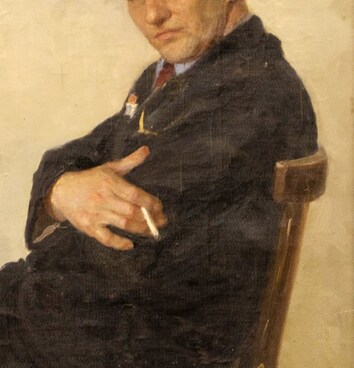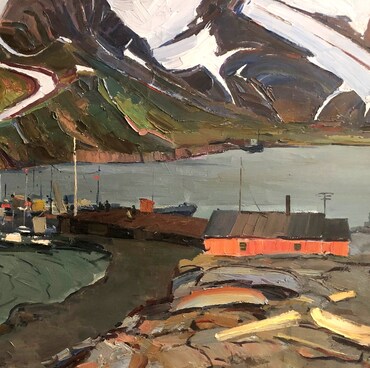Yury Ivanovich Bykov is a Distinguished Artist of the Russian Federation and one of the most unusual and creative painters of the Russian Far East.
Born in Khabarovsk in 1950 into a family of a military man, he planned to study at the Moscow Institute of Physics and Technology. He failed to get there but instead passed the entrance exams to the art and graphics department of the Khabarovsk Pedagogical Institute. His graduation project — a series called “Metamorphoses” — already showed signs of the artist’s peculiar, provocative style.
In 1972, Yury Ivanov Bykov came to Komsomolsk-on-Amur, and his first solo exhibition was held that same year. At the time, a community of like-minded artists began to form in the city; each had an unconventional perception of life and art and the prospect of participating in international projects. The artists held meetings at the creative base “Senezh”, discussing new ways of decorative and figurative expression in the visual arts. Bykov eventually joined this elite artistic community. Since the early 1980s, he participated in many exhibitions and continued to work extensively even in the difficult 1990s.
In his works, the artist starts with a metaphor, then transitions to a symbol and after that — to a sign. Among the techniques he has mastered are etching, drawing, watercolor, photography, and oil painting.
He has chosen a combination of a collage technique with a mixture of materials and other techniques as the most suitable means to convey the tension and sophisticated nature of 20th-century art. This manner of expression creates a diverse dynamic space and prompts the viewer to process the painting not only aesthetically but also intellectually.
The triptych “Musk Deer’s Trail” is made using the mixed media technique: Yury Bykov used oil paint and organic materials — dry leaves and grass. In terms of composition, the work resembles a petroglyph transferred onto the canvas: the center features a stylized figure of a hunter, and the lower right corner depicts a Siberian musk deer; the left part is reserved for the abstraction with green grass peeking out from under the snow. All three parts of the triptych create a dynamic story and establish a dialogue between people and nature.
On closer examination, carved masks, ancient petroglyphs, patterns, and the image of the saven (the right part of the triptych) create a blend of the dense taiga and the Nanai epic.
In 1981, Yury Ivanovich Bykov joined the Artists’ Union of Russia, and since 1984, his paintings have been exhibited in Poland, Germany, Italy, Hungary, the USA, Japan and Ethiopia.
Born in Khabarovsk in 1950 into a family of a military man, he planned to study at the Moscow Institute of Physics and Technology. He failed to get there but instead passed the entrance exams to the art and graphics department of the Khabarovsk Pedagogical Institute. His graduation project — a series called “Metamorphoses” — already showed signs of the artist’s peculiar, provocative style.
In 1972, Yury Ivanov Bykov came to Komsomolsk-on-Amur, and his first solo exhibition was held that same year. At the time, a community of like-minded artists began to form in the city; each had an unconventional perception of life and art and the prospect of participating in international projects. The artists held meetings at the creative base “Senezh”, discussing new ways of decorative and figurative expression in the visual arts. Bykov eventually joined this elite artistic community. Since the early 1980s, he participated in many exhibitions and continued to work extensively even in the difficult 1990s.
In his works, the artist starts with a metaphor, then transitions to a symbol and after that — to a sign. Among the techniques he has mastered are etching, drawing, watercolor, photography, and oil painting.
He has chosen a combination of a collage technique with a mixture of materials and other techniques as the most suitable means to convey the tension and sophisticated nature of 20th-century art. This manner of expression creates a diverse dynamic space and prompts the viewer to process the painting not only aesthetically but also intellectually.
The triptych “Musk Deer’s Trail” is made using the mixed media technique: Yury Bykov used oil paint and organic materials — dry leaves and grass. In terms of composition, the work resembles a petroglyph transferred onto the canvas: the center features a stylized figure of a hunter, and the lower right corner depicts a Siberian musk deer; the left part is reserved for the abstraction with green grass peeking out from under the snow. All three parts of the triptych create a dynamic story and establish a dialogue between people and nature.
On closer examination, carved masks, ancient petroglyphs, patterns, and the image of the saven (the right part of the triptych) create a blend of the dense taiga and the Nanai epic.
In 1981, Yury Ivanovich Bykov joined the Artists’ Union of Russia, and since 1984, his paintings have been exhibited in Poland, Germany, Italy, Hungary, the USA, Japan and Ethiopia.





